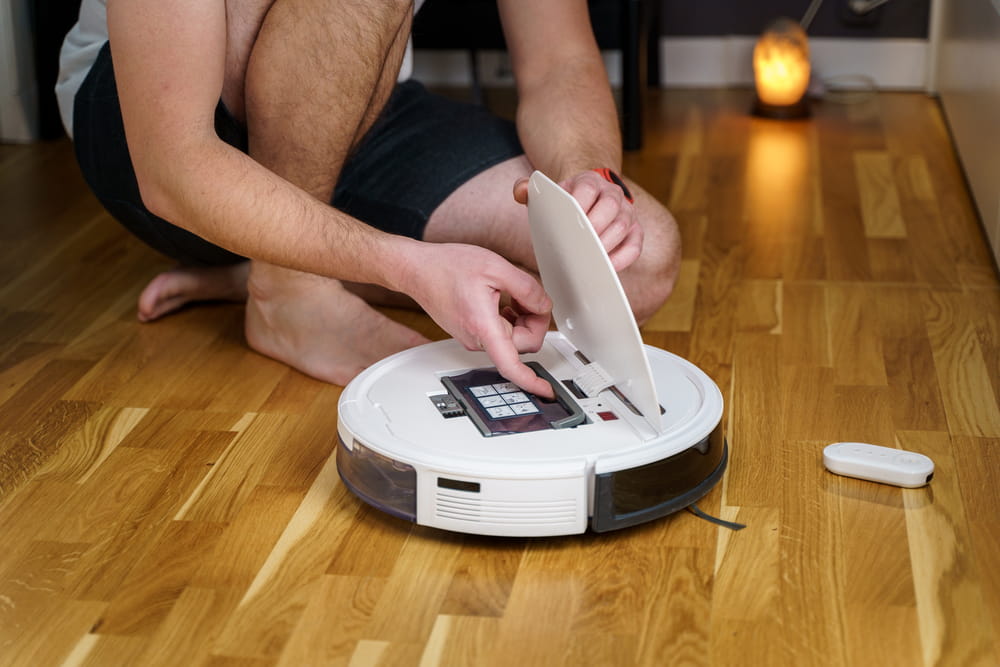Robot vacuums are versatile and are able to clean places not accessible to the conventional vacuum. So, how do you empty a clean robot floor cleaner?
They’re convenient, able to save time on chores. And they’re generally very easy to use and maintain. This latter point is important, as it takes some routine maintenance to ensure that your robot vacuum is operating up to its full potential.
One regular task that you’ll have to perform is emptying the waste bin. Unlike most conventional vacuum cleaners, according to Wired, the average robot vacuum’s waste bin is only about 0.6 liters. This means that you’ll need to empty it often.
In this post, we’ll take a look at how to perform this and share other maintenance tips to ensure you’re getting the most out of your robot vac. Here’s a look:
Emptying a Robot Floor Cleaner: Step-by-Step Directions
While emptying the waste bin on the robot vacuum may vary slightly depending on the manufacturer, all models follow a fairly similar pattern that’s quite easy and fast to perform. Here’s a look at how to empty the device:
- Undock the robot vacuum from its charging station.
- Look for where the waste bin is located. This should be fairly easy to identify. It’s usually located near the back of the robot vacuum near a tab that must be triggered to release it.
- Once you’ve located and pressed the release tab, gently pull the waste bin out of the device.
- Empty the waste bin into a garbage can.
- Gently slide the waste bin back into its proper place in the robot vacuum cleaner. Often times, you’ll hear the release tab click when it’s properly inserted.
In addition to emptying the waste bin out regularly, it’s also a good idea to give it a more thorough cleaning on occasion to dislodge any debris that has built up inside of it. There’s various other maintenance that you should be carrying out in addition to cleaning the waste bin as well, which we’ll get to later on in this piece.
How Often Do You Need to Empty a Robot Vacuum Cleaner?
Because robot vacuums tend to have much smaller waste bins that conventional standup vacuum cleaners, most manufacturers recommend emptying the device after each use. Failure to do so, and your vacuum won’t be suctioning up any dirt and debris any longer. Instead, the debris will have nowhere to go and will just wind up being transported all around your home as the robot vacuum works.
If you don’t think you can commit to manually emptying the waste bin on your robot vacuum after each use, the good news is that today’s more advanced models can self-empty. That is, when the vacuum detects that the waste bin is full, it will self-empty into a larger bin on its docking station.
In fact, some models of robot vacuums are designed so that the larger bins are designed to hold up to 60 full bins full of debris. You’ll still have to empty this larger waste bin that the robot vacuum empties into, but you’ll have to do so far less often than if you were to empty the waste bin on the robot vacuum itself.
Other Tips for Owning a Robot Vacuum Cleaner
In addition to regularly emptying and occasionally cleaning the waste bin, there are other maintenance tips that you should be abiding by to get the most out of your robot vacuum. Here’s a look at some of them:
Cleaning, Changing the Filter
Most vacuum manufacturers recommend cleaning the air filter at least once a week and changing it every few months. Clean it by removing it and tapping it against the inside of a garbage can to help dislodge any debris.
You may also wash it, though make sure it’s completely dry before inserting it back into the device or you risk damaging the robot vacuum. If you live in a home with pets or with lots of foot traffic, consider changing the filter every few months. Otherwise, you should only have to change it once or twice a year.
Clean Wheels and Brushes
The wheels and brushes of the robot vacuum do a lot of work, so they’ll need to be properly maintained too. For instance, debris often builds up on them over time, so be sure to occasionally spend time cleaning them.
Wipe the Sensors
The sensors essentially help your robot vacuum “see,” so it’s crucial to make sure that they’re free of dirt and dust. You can do this easily by using a microfiber cloth or dampened rag. Also, be sure you’re doing this with your device’s metal contacts so that it charges properly in the docking station.
